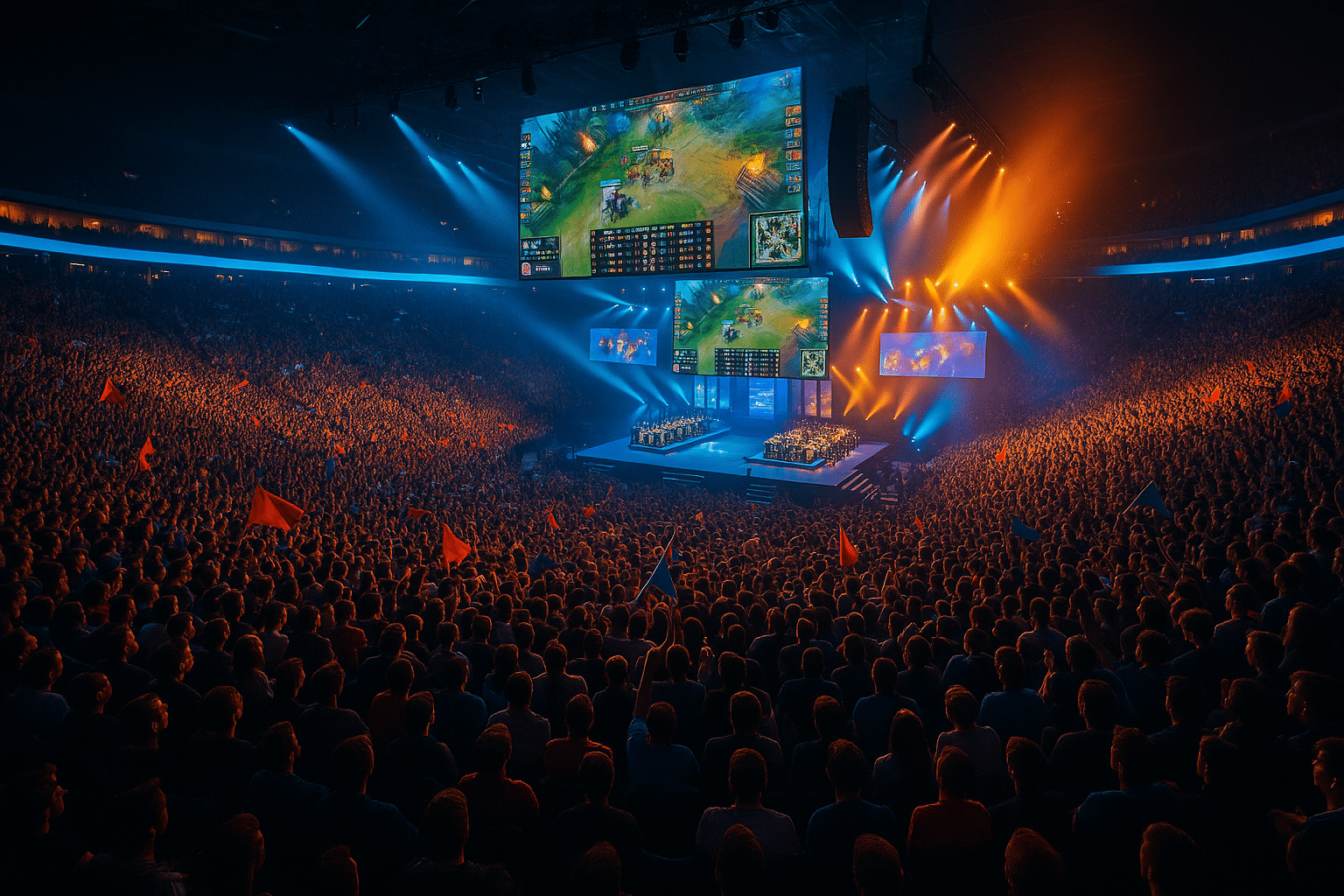The Rise of Esports: From LAN Parties to Global Arenas
The rise of esports began with small gatherings of passionate video game players and has since exploded into a global phenomenon. In the past two decades, competitive video gaming – once seen as a niche hobby – has transformed into a professional industry with massive tournaments, celebrity gamers, and even consideration for inclusion in the Olympics. This meteoric rise of esports (short for electronic sports) is a story of technology, community, and cultural shift. Let’s explore how esports evolved from informal basement tournaments to filling arenas and capturing the attention of hundreds of millions of fans worldwide, fueling the continued rise of esports.
Humble Beginnings: LAN Parties and Early Competitions
Esports has its roots in the 1980s and 1990s, when gamers would gather for local tournaments. In the beginning, these were often LAN parties – friends connecting their computers in the same room to play multiplayer games like Doom, StarCraft, or Counter-Strike. Prizes were bragging rights or maybe a slice of pizza, not multi-million dollar checks. The 1980s had some high-score contests (for example, classic arcade games like Pac-Man or Donkey Kong had competitive scenes documented in films like The King of Kong), but it was the 90s and early 2000s when competitive gaming truly began to organize. Sega and Nintendo held early championships – like Nintendo’s World Championships (1990) – touring cities with contestants competing for the highest scores in Mario and Tetris. These were essentially promotional events, but they planted the idea that gamers could be champions.
A major turning point came with the game StarCraft (1998) in South Korea. StarCraft, a military science-fiction strategy game, became a national obsession. Televised matches on Korean TV drew impressive viewership. By the early 2000s, South Korea had professionalized gaming: there were esports teams, sponsorships from electronics companies and telecoms, and players who achieved celebrity status akin to pro athletes. The rest of the world took notice when Korean StarCraft stadium events began packing thousands of fans. It showed that competitive gaming could captivate live audiences. Around the same time, first-person shooter tournaments for games like Counter-Strike and fighting game competitions (like the EVO Championship Series for games such as Street Fighter) were steadily growing in the West. These competitions were still relatively underground, but this was an early stage in the rise of esports as a global subculture, laying the foundation for future growth.
The Internet Boom and Global Expansion
The rise of high-speed internet in the 2000s truly opened the floodgates for esports. Suddenly, players could compete with others around the globe without leaving home. Online ladders, leaderboards, and clan rivalries drove up the skill ceiling as top players kept seeking tougher opponents on the internet. Game developers started to nurture competitive scenes for their popular titles. Blizzard Entertainment launched official international tournaments for Warcraft and StarCraft. Valve Corporation introduced the Counter-Strike esports circuit and later, in 2011, created The International – a world championship for their new game Dota 2 – with an unprecedented $1 million prize pool at the time (a figure that would balloon dramatically by the end of the decade).
By the 2010s, esports was no longer an obscure pastime. Live streaming platforms like Twitch (founded in 2011) enabled millions of fans to watch gamers play in real time from anywhere in the world. This was a game-changer in the rise of esports: tournaments that might have had a few thousand in-person attendees could suddenly reach global viewership comparable to traditional sports broadcasts through online streams. For instance, the 2013 League of Legends World Championship sold out the Staples Center in Los Angeles and drew tens of millions of online viewers, marking another milestone in the rise of esports worldwide. Big brands and advertisers saw the eyeballs and started investing money, sponsoring teams and events. Esports leagues formed for various games: Riot Games established regional leagues for League of Legends, and Activision Blizzard later launched the Overwatch League with a city-based franchise model reminiscent of the NFL or NBA.
Major traditional sports owners and celebrities bought into esports teams. Names like NBA legend Michael Jordan, NFL owner Robert Kraft, and celebrities like Drake and Will Smith became investors in esports franchises. This influx of capital further legitimized the scene. Production quality for tournaments skyrocketed: slick broadcasts with professional commentators (called “shoutcasters”), player interviews, and analysis segments became standard, making the viewing experience more polished for newcomers. By the late 2010s, global esports viewership was estimated in the hundreds of millions annually. Competitive gaming had truly become an international spectator sport. This turning point cemented the rise of esports on a global scale.
Esports Today: Big Money, Big Audiences, Big Future
Fast forward to today, and the rise of esports has created a multi-billion dollar industry. The largest tournaments boast prize pools that rival those of traditional sporting events. Top esports players, like those in League of Legends or Fortnite, can earn seven-figure incomes from tournament winnings, salaries, and sponsorships. Streaming deals also allow star players to earn money by broadcasting their practice sessions or playing for fans between competitions. Professional teams have coaches, analysts, nutritionists, and esports training houses where players live and practice together – all resembling the infrastructure of a traditional sports team. This growth shows no signs of slowing, with the rise of esports continuing to dominate digital entertainment.
The audience for esports skews younger, mostly in the 16–35 age range, a demographic highly coveted by advertisers. Companies from computer hardware makers to energy drink brands and auto manufacturers sponsor esports leagues or advertise during streams. Notably, even some non-endemic brands (those outside gaming) like Coca-Cola and Nike have jumped in, the latter even signing sponsorships with individual players and teams. Stadium events for esports are now global: from the USA to Europe to China, it’s not unusual to see an arena packed with cheering fans waving team banners and wearing jerseys – except they’re watching digital action on a big screen rather than a physical ball or puck.
“From bedroom streams to sold-out arenas — esports shows how community and connectivity can build a new kind of sport.”

Challenges and the Road Ahead
With success come challenges. The esports industry is figuring out sustainable economic models – some leagues expanded too rapidly and have had to contract or rethink their approach to turning viewership into profit. Player burnout is another issue: top competitors often practice 10+ hours a day, which can lead to fatigue or health issues, and esports careers can be short. There’s also the challenge of maintaining competitive balance and fighting cheating (hacks or illicit software) in an online environment. Still, these issues are being addressed as the scene matures, ensuring the rise of esports remains sustainable.
Looking forward, esports is poised to keep growing. New games constantly emerge and can become hits (think of how Fortnite took off seemingly overnight). Moreover, as technology like virtual reality (VR) and augmented reality improves, we might see entirely new forms of competitive gaming that blur the line between physical and digital. Some predict that interactive spectator elements (where viewers can perhaps influence certain game elements live) could become part of the experience, making esports even more engaging than passive sports watching.
Conclusion
In conclusion, the rise of esports from basement tournaments to global arenas is a remarkable journey indicative of the digital age. The future of the rise of esports will likely reshape how the world views competition and entertainment It highlights how community passion, coupled with technological connectivity, can create something few imagined would be so big. Today’s esports champions are celebrated like athletes, complete with roaring crowds and worldwide fanbases. And as gaming continues to embed itself in popular culture, esports will likely be right at the forefront – a testament to how far playing video games can truly go.
Quick Templates (Copy-Paste)
1) New Fan Starter PackGame: {LoL/CS/Valorant/Dota2} | Team to follow: {name} | Event calendar: {links}
Learn basics: {2 tutorial vids} | Follow: {casters/analysts} | Matchday checklist: stream link, schedule, format, key players.
2) Player Routine OutlineDaily blocks: VOD review (60m), mechanics (90m), scrims (3–4h), physical (30m mobility), mental (15m mindfulness), sleep (8h). Weekly: 1 full rest day.
3) Brand/Sponsor ChecklistAudience fit: {age/regions} | Brand safety: {guidelines} | Formats: jersey, stream assets, content series, event booth | KPIs: reach, watchtime, conversions.
Mini-FAQ
Are esports really “sports”?
Debate continues, but the structure (teams, leagues, training, coaching) and spectator scale mirror traditional sports — with the competition happening in games.
How do pro players make money?
Salaries from teams, tournament winnings, sponsorships, and streaming/content revenue.
What games are biggest in esports?
Titles vary by region, but common staples include League of Legends, Dota 2, Counter-Strike, Valorant, Fortnite, and major fighting games at EVO.
Can esports be in the Olympics?
It’s been discussed and trialed in parallel events; formal inclusion remains under consideration as the landscape evolves.
How can a newcomer start watching?
Pick one game, learn basic rules via short tutorials, follow one league/team, and watch highlight VODs before diving into full live events.
Further Reading
- The Esports Observer — Industry News & Analysis
- LoL Esports — Schedules & Streams
- Valve — Dota 2 & Counter-Strike Majors (publisher hub)
- Twitch — Esports Directory
- EVO — Fighting Game Championship Series
